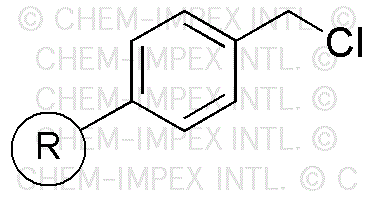Chloromethylated polystyrene is widely utilized in research focused on:
- Polymer Chemistry: It serves as a versatile building block for synthesizing various copolymers, enhancing properties like strength and thermal stability.
- Ion Exchange Resins: This compound is crucial in the production of ion exchange resins used in water purification and chemical separation processes, offering high selectivity and efficiency.
- Pharmaceutical Applications: It acts as a functionalized support in drug delivery systems, allowing for targeted release and improved bioavailability of therapeutic agents.
- Adhesives and Sealants: Its unique chemical structure provides excellent adhesion properties, making it ideal for formulating high-performance adhesives used in construction and automotive industries.
- Surface Modification: Chloromethylated polystyrene is employed in modifying surfaces to enhance compatibility with various materials, improving performance in applications like coatings and composites.
General Information
Properties
Safety and Regulations
Applications
Chloromethylated polystyrene is widely utilized in research focused on:
- Polymer Chemistry: It serves as a versatile building block for synthesizing various copolymers, enhancing properties like strength and thermal stability.
- Ion Exchange Resins: This compound is crucial in the production of ion exchange resins used in water purification and chemical separation processes, offering high selectivity and efficiency.
- Pharmaceutical Applications: It acts as a functionalized support in drug delivery systems, allowing for targeted release and improved bioavailability of therapeutic agents.
- Adhesives and Sealants: Its unique chemical structure provides excellent adhesion properties, making it ideal for formulating high-performance adhesives used in construction and automotive industries.
- Surface Modification: Chloromethylated polystyrene is employed in modifying surfaces to enhance compatibility with various materials, improving performance in applications like coatings and composites.
Documents
Safety Data Sheets (SDS)
The SDS provides comprehensive safety information on handling, storage, and disposal of the product.
Product Specification (PS)
The PS provides a comprehensive breakdown of the product’s properties, including chemical composition, physical state, purity, and storage requirements. It also details acceptable quality ranges and the product's intended applications.
Certificates of Analysis (COA)
Search for Certificates of Analysis (COA) by entering the products Lot Number. Lot and Batch Numbers can be found on a product’s label following the words ‘Lot’ or ‘Batch’.
*Catalog Number
*Lot Number
Certificates Of Origin (COO)
This COO confirms the country where the product was manufactured, and also details the materials and components used in it and whether it is derived from natural, synthetic, or other specific sources. This certificate may be required for customs, trade, and regulatory compliance.
*Catalog Number
*Lot Number
Safety Data Sheets (SDS)
The SDS provides comprehensive safety information on handling, storage, and disposal of the product.
DownloadProduct Specification (PS)
The PS provides a comprehensive breakdown of the product’s properties, including chemical composition, physical state, purity, and storage requirements. It also details acceptable quality ranges and the product's intended applications.
DownloadCertificates of Analysis (COA)
Search for Certificates of Analysis (COA) by entering the products Lot Number. Lot and Batch Numbers can be found on a product’s label following the words ‘Lot’ or ‘Batch’.
*Catalog Number
*Lot Number
Certificates Of Origin (COO)
This COO confirms the country where the product was manufactured, and also details the materials and components used in it and whether it is derived from natural, synthetic, or other specific sources. This certificate may be required for customs, trade, and regulatory compliance.


